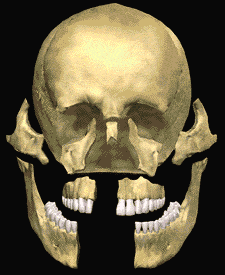Dental Implants

Dr. Villano employs the latest dental implant technology to help replace missing teeth and to give his patients the ability to smile and chew again with confidence – all while retaining the look and feel of your own natural teeth.
Dental implants are small titanium posts surgically placed into the jaw bone that allow a secure anchor for artificial replacement teeth. For most patients, dental implant surgery is completed in two procedures. The first procedure involves placing the implant posts and, after a healing period in which the posts bond with the jaw, is followed by the attachment of the replacement teeth. Sometimes, if an extraction is required, dental implants can be placed at the time of the extraction, eliminating the need for additional visits.
Dr. Villano works closely with your dentist to create a comfortable prosthesis that fits like your natural teeth. If you require a single tooth replacement, more extensive multiple dental implants, or full mouth tooth replacement, schedule an implant consultation to find out if implant dentistry is right for you.
Bone Grafting

A bone graft is a procedure where a surgeon replaces or fosters growth of bone tissue in order to regenerate bone mass. Bone grafts can range in complexity from a minor procedure, to full facial reconstuction.
When a tooth is missing for a period of time, the jaw bone can deteriorate or recede, and a bone graft is required to allow for tooth replacement. Repairing the bone structure allows for a solid foundation for implant placement. By adding bone tissue from a tissue bank, or from another part of the body, it is possible to allow the tissue to mature and fuse with the jawbone. This is called guided bone regeneration.
In cases where complex reconstruction is required bone grafting can assist in repairing defects in the jaw caused by traumatic injuries, surgeries, or birth defects.
Wisdom Teeth

Wisdom teeth develop in most people between the ages of 16 and 25 and if impacted or crooked can affect other teeth and cause infection, discomfort and other oral complications.
Because wisdom teeth are the last teeth to erupt they tend to crowd the other adult teeth and cause pain, discomfort and can create issues with tooth and bite alignment.
Dr. Villano can diagnose and evaluate the position of wisdom teeth during a simple oral examination and the use of x-ray technology. If a problem with the wisdom teeth is diagnosed it is typically recommended that they be extracted. This is a routine procedure that, for most patients, is performed under local anesthesia with as little discomfort as possible.
We recommend that parents have their teen evaluated before the wisdom teeth erupt, but it is never too late for a wisdom tooth consultation.
Jaw Surgery

Jaw surgery, or Orthognathic surgery, can be required when a patients jaw is positioned incorrectly due to uneven growth, a defect or an injury. Speech, chewing function and overall oral health can be affected if a problem in the jaw exists. Surgery can be an effective option in cases where traditional orthodontics are unable to fix the issue.
Symptoms may include:
- Difficulty in chewing, biting or swallowing
- Speech problems
- Chronic jaw or TMJ pain
- Open bite
- Protruding jaw
- Breathing problems
Dr. Villano uses state-of-the-art digital techniques to evaluate and prepare surgical treatment plans allowing for greater accuracy and reduced healing times.
Pre-Prosthetic Surgery

Sometimes, before a prosthesis can be placed, it is necessary to prepare the mouth, this is called Pre-Prosthetic Surgery. Some reasons for pre-prosthetic surgery may be:
- Bone smoothing or reshaping
- Excess bone
- Bone ridge reduction
- Excess gum tissue
- Exposure of impacted teeth
Oral Pathology

It is important to monitor the health of your oral tissue. If you notice any of the following signs, please seek further examination, as they can be signs of cancerous or precancerous growth.
Reddish patches (erythroplasia) or whitish patches (leukoplakia) in the mouth.
- A sore that fails to heal and bleeds easily.
- A lump or thickening on the skin lining the inside of the mouth.
- Chronic sore throat or hoarseness. Difficulty in chewing or swallowing. Your mouth can be an early warning system for serious health issues, so be sure to pay attention to any signs and perform self examinations regularly, in addition to oral cancer screenings at your dental visits.
TMJ Disorders

Temporomandibular joint and muscle disorders, commonly called “TMJ,” are a group of conditions that cause pain and dysfunction in the jaw joint and the muscles that control jaw movement. We don’t know for certain how many people have TMJ disorders, but some estimates suggest that over 10 million Americans are affected. The condition appears to be more common in women than men.
For most people, pain in the area of the jaw joint or muscles does not signal a serious problem. Some people, however, develop significant, long-term symptoms.
A variety of symptoms may be linked to TMJ disorders. Pain, particularly in the chewing muscles and/or jaw joint, is the most common symptom. Other likely symptoms include:
- radiating pain in the face, jaw, or neck,
- jaw muscle stiffness,
- limited movement or locking of the jaw,
- painful clicking, popping or grating in the jaw joint when opening or closing the mouth,
- a change in the way the upper and lower teeth fit together.
Dr. Villano is qualified to diagnose and treat TMJ disorders, if you experience any or all of the above symptoms contact our office for a consultation today.
Sleep Apnea

Sleep Apnea affects sufferers by causing pauses in breathing while sleeping. The pauses, which can last from a few seconds to minutes and may occur up to 30 times or more an hour, disrupt sleeping patterns resulting in excessive daytime sleepiness. Sleep apnea is considered a serious medical condition and most major medical plans offer coverage of treatment.
Dr. Villano is experienced in consulting those with sleep apnea and helping them find relief with both non-surgical and surgical techniques. Call today and get the rest you deserve.
Cleft Lip and Palate

Cleft lip (cheiloschisis) and cleft palate (palatoschisis), which often occur together, are a congenital birth defect caused by abnormal facial development during pregnancy. This non-fusion of the body’s natural structures that formed before birth affects 1 in 700 children worldwide.Treatment can safely be performed after a child reaches between 7 and 18 months old.
Repairing a cleft, or gap, in the lip,or palate (or both) requires a team of professionals among which a maxillofacial surgeon plays an integral role. Dr. Villano works with a team of doctors and specialists at Doernbecher Children’s Hospital, where they use the latest advances in maxillofacial surgery to close the gap or hole between the roof of the mouth and the nose, reconnect the muscles that make the palate work, and repair the palate for proper function.
Facial Trauma

Traumatic injuries to the face are not only physically devastating but they are emotionally traumatic as well, and it is the maxillofacial surgeon’s responsibility to manage and treat that trauma over the course of the patient’s rehabilitation.
Dr. Villano is on staff at several area hospitals and clinics and is highly trained and experienced in treating injuries and conditions inluding:
- Facial lacerations
- Intra oral lacerations
- Avulsed (knocked out) teeth, and the surrounding dental structures
- Fractured facial bones (cheek, nose or eye socket) Bone Injur
- Fractured jaws (upper and lower jaw)
- Soft Tissue Injuries
- Bone Injuries